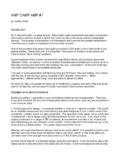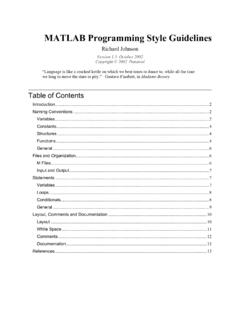Transcription of SENSEMAKING - SAGE Publications Inc
1 3 This chapter introduces SENSEMAKING as a key leadership capability for the complex and dynamic world we live in today. SENSEMAKING , a term introduced by Karl Weick, refers to how we structure the unknown so as to be able to act in it. SENSEMAKING involves coming up with a plausible understanding a map of a shifting world; testing this map with others through data collection, action, and conversation; and then refining, or abandoning, the map depending on how credible it is. SENSEMAKING enables leaders to have a better grasp of what is going on in their environments, thus facilitating other leadership activities such as visioning, relating, and inventing.
2 This chapter outlines ten steps to effective SENSEMAKING , grouped under enabling leaders to explore the wider system, create a map of that system, and act in the system to learn from it. It illustrates how rigidity, leader dependence, and erratic behavior get in the way of effective SENSEMAKING , and how one might teach SENSEMAKING as a core leadership capability. The chapter ends with a student manual on SENSEMAKING from an MBA leadership class. u Deborah AnconaMIT-Sloan School of ManagementSENSEMAKINGF raming and Acting in the Unknown14 The Handbook for Teaching LeadershipAt the MIT Sloan School of Management we teach the 4-CAP model of lead-ership capabilities.
3 The four capabilities include SENSEMAKING , relating, visioning, and inventing (Ancona, Malone, Orlikowski, & Senge, 2007).While participants in our leadership workshops and classes are reasonably com-fortable with the idea that relating is about building trusting relationships among peo-ple and across networks, visioning involves painting a compelling picture of the future and what is possible, and inventing means creating the structures and processes needed to move toward the vision, most scratch their heads at the term SENSEMAKING .
4 And yet our 360-degree survey data reveal that SENSEMAKING is highly correlated with lead-ership effectiveness even more than vision-ing. In addition, when people finish our programs and even five years later they report that SENSEMAKING was one of the most valuable concepts and skills they have learned. SENSEMAKING lingers in organi-zational vocabulary long after our courses are what is SENSEMAKING , and why is it so central to effective leadership?What Is SENSEMAKING ?Karl Weick, the father of SENSEMAKING , suggests that the term means simply the making of sense (Weick, 1995, p.)
5 4). It is the process of structuring the unknown (Waterman, 1990, p. 41) by placing stimuli into some kind of framework that enables us to comprehend, understand, explain, attribute, extrapolate, and predict (Starbuck & Milliken, 1988, p. 51). SENSEMAKING is the activity that enables us to turn the ongo-ing complexity of the world into a situation that is comprehended explicitly in words and that serves as a springboard into action (Weick, Sutcliffe, & Obstfeld, 2005, p. 409). Thus SENSEMAKING involves and indeed requires an articulation of the unknown, because, sometimes trying to explain the unknown is the only way to know how much you understand , SENSEMAKING calls for courage, because while there is a deep human need to understand and know what is going on in a changing world, illuminating the change is often a lonely and unpopular task.
6 The leader who demonstrates that an organiza-tion s strategy has not been successful, for example, may clash with those who want to keep the image of achievement the realm of business, SENSEMAKING can mean learning about shifting markets, customer migration, or new technologies. It can mean learning about the culture, poli-tics, and structure of a new venture or about a problem that you haven t seen before. It can mean figuring out why a previously suc-cessful business model is no longer working.
7 SENSEMAKING often involves moving from the simple to the complex and back again. The move to the complex occurs as new information is collected and new actions are taken. Then as patterns are identified, and new information is labeled and categorized, the complex becomes simple once again, albeit with a higher level of is most often needed when our understanding of the world becomes unintelligible in some way. This occurs when the environment is changing rapidly, presenting us with surprises for which we are unprepared or confronting us with adaptive rather than technical problems to solve (Heifetz, 2009).
8 Adaptive challenges those that require a response outside our existing repertoire often present as a gap between an aspiration and an existing capacity a gap that cannot be closed by existing modes of such times phenomena have to be forcibly carved out of the undifferentiated flux of raw experience and conceptually fixed and labeled so that they can become the common currency for communication exchanges (Chia, 2000, p. 513). As such, SENSEMAKING is about making the intrac-table actionable.
9 But action is not a sepa-rate and later step in SENSEMAKING . Rather, acting is one more way of understanding SENSEMAKING 5the new reality, providing additional input for us to bracket and assign meaning (Weick et al., 2005).Thus, SENSEMAKING involves coming up with plausible understandings and mean-ings; testing them with others and via action; and then refining our understand-ings or abandoning them in favor of new ones that better explain a shifting Arthur (1996) uses a gambling casino analogy to illustrate the kind of pro-found uncertainty we currently face that creates a great need for SENSEMAKING :Imagine you are milling about in a large casino with the top figures of high tech.
10 Over at one table, a game is starting called Multimedia. Over at another is a game called Web Services. There are many such tables. You sit at one. How much to play? you ask. Three billion, the croupier replies. Who ll be playing? you ask. We won t know until they show up, he replies. What are the rules? These will emerge as the game unfolds, says the croupier. What are the odds of winning? you wonder. We can t say, responds the house. Do you still want to play?














